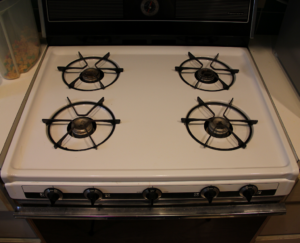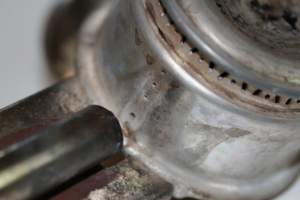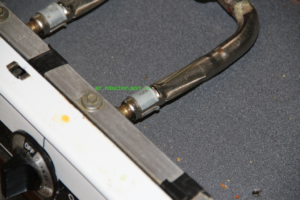 |
| The patient needing attention |
The above is my stove. It is an old stove. I think I have used this stove once in five years. I don’t really care much about the stove. Unfortunately someone recently pointed out to me the burners on the stove do not light correctly. So in accordance with my ‘fix ALL the things’ policy it was torn apart until fixed or destroyed, whichever came first. Mercifully this ended in a fixing and what follows is what I discovered.
Overview and Operation
 |
| stove with the top removed |
Opening the top of this stove is as simple as lifting the top from the front. Once raised the top can be slide off of its hinges exposing the amazingly primitive bits underneath. The gas line comes in from the upper left and travels down the left side to (what I think is) a regulator, a flame arrester, or both. This gas line then takes a 90 degree bend and forms the main fuel rail at the front of the stove.
Each of the four knobs for the burners and the one for the oven all open valves off of this line to supply fuel to their respective elements. When you turn on a burner fuel travels down its supply line, pulls some air in (more on this later), and fills the burner element. Turning the knob on also starts the igniters located in between the burners which share it (both igniters fire regardless of which burner you are lighting).
 |
| closeup of the ignition flame ports |
Each burner has a set of flame ignition ports on the side facing its igniter. Fuel from these ports travels down a hollow tube to the igniter. Once lit the flame travels up the tube to the ports on the burner. From here the flame travels up to the closest main burner ports and then around until all of the element is lit.
Problems and how to clean them
Assuming your ingiters are working (you can hear if they are firing and if they are not you have an issue which will not be covered here) the most likely cause of the burner either failing to light or not lighting completely is ash build up in the flame ports. To fix this you simply need to remove and clean the burner element. For my stove the elements can be removed without tools.
Start by removing the spring clip for the burner. Then rotate the burner until it is free of its supports and then slide it off of its fuel nozzle With the element free simply clean it with a stiff brush then blast some compressed air through the gas inlet. When cleaning the burner don’t forget to clean the vertical ignition ports on the side in addition to the horizontal main ports at the top. Do not use any tools which could change the shape of the flame ports. Marring the ports on your burner will give you other issues not addressable with cleaning. You will want to use the compressed air outside as it can blast a surprising amount of ash out of the burner.
Elements can acquire a good deal of grease and other nastiness on them over time. Unless the offending matter is blocking a port it is not necessary to remove it. If you do choose to do a deep cleaning of a burner remember it must be completely rinsed and dry before it is re-installed.
Why is there a slot in the fuel line?
 |
| air induction port |
These port are intentional. All combustion requires fuel (in this case natural gas) and an oxidizer (normal air). When gas passes through this segment of tubing it creates an area of low pressure around this port (via venturi effect) and pulls in the surrounding air. This fuel air mix is delivered to the burner for combustion.
Normally these ports are too far from any opening in the stove top to get dirty so you likely will not need to clean them. Just be aware of them when working on the stove as anything blocking or interfering with them will cause issues.



